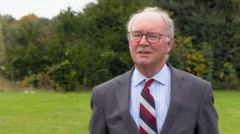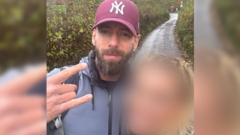
U.S. officials who specialize in terrorism prevention are bracing for their office to be eliminated or broken up as the State Department readies to root out what Secretary Marco Rubio calls a “radical political ideology” embedded in a “sprawling bureaucracy.”
The plan to eliminate the Office of Countering Violent Extremism (CVE), along with offices that further human rights and prevent war crimes, was first reported by the Free Press. Rubio appeared to confirm the reporting, sharing a link and describing “the real exclusive on how we’re making the State Department Great Again.”
“I don’t know what the plans are, and I’m not sure that the department or Secretary Rubio knows,” Ian Moss, a former counterterrorism official, told Raw Story. “But to dilute the concerted efforts by the office and push it out to other parts of the department will have real fundamental impact on our ability to engage in thoughtful preventive action. And it will ultimately make us less safe.”
Moss oversaw CVE during the Biden administration, as deputy coordinator for counterterrorism, and now practices at the law firm Jenner & Block. While the “speed” and “thin justification” for cuts across the federal government belies the notion that there is any coherent plan, Moss said, he believes former colleagues are “anticipating that their office will be closed.”
Part of the Bureau of Counterterrorism, CVE uses tools including counter-messaging, international cooperation and intelligence sharing, and rehabilitation.
The State Department did not directly address a question from Raw Story about plans for CVE, but instead pointed to a proposed organization chart that showed the Counterterrorism Bureau moved to report to the Undersecretary for Arms Control and International Security. The move “will make the office stronger and better postured to stay ahead of America’s adversaries,” the department said, in a statement attributed to an unnamed senior official.
Moss said: “If you are successful on your CVE effort at one end of the spectrum, then you don’t have to drop bombs at the other end of the spectrum.”
That was a striking contrast to the philosophy of Sebastian Gorka, the White House counterterrorism advisor who likes to highlight a military strike ordered by President Donald Trump against an ISIS base in a cave complex in northern Somalia as indicative of the administration’s new counterterrorism policy. Gorka’s X biography includes the acronym “WWFY&WWKY,” which stands for “we will find you and we will kill you.”
From 2022 to 2024, Moss had a unique view of how CVE’s work intersected with other areas of counterterrorism because he also oversaw the Office of Terrorist Detentions. He said the offices “worked hand-in-glove” to repatriate hundreds of women and children from Al Hol, a camp in northeast Syria for people displaced by ISIS, to home countries in central Asia. CVE worked “to help returnees receive rehabilitative services and reintegrate into their communities of origin.”
“That would be devastating if that work goes away,” said William Braniff, executive director at the Polarization and Extremism Research & Innovation Lab at American University. “If there are not programs to de-risk these individuals, and if these individuals don’t have empowering opportunities elsewhere, they will find empowering opportunities with extremist groups again.”
In March, after eight probationary members of his staff were terminated, Braniff resigned as director of the Center for Prevention Programs and Partnerships, better known as CP3, at the Department of Homeland Security.
Braniff said he expects that office will be shut down completely. Braniff described CVE and CP3 as “sister offices”, one focused abroad, the other on the homeland.
‘Extremists of all stripes’
Trump officials are signaling diminished interest in combating the threat of white supremacist terror. In 2017, Gorka said white supremacy was not a problem. Since returning to the White House in January, he has remained silent on the matter.
FBI Director Kash Patel previously accused the Biden administration of fabricating the threat of domestic terrorism as a pretext for harassing conservatives. Following his FBI nomination, a spokesperson for the Trump transition told Raw Story Patel would “protect Americans from terrorism,” without addressing his view of white supremacist threats.
 FBI Director Kash Patel attends a House Intelligence Committee hearing about worldwide threats. REUTERS/Leah Millis
FBI Director Kash Patel attends a House Intelligence Committee hearing about worldwide threats. REUTERS/Leah Millis
While more of CVE’s work has focused on Islamist extremism and “misuse of technology by extremists of all stripes,” Moss said the office “has also been the principal driver of addressing racially or ethnically motivated violent extremism, including white identity terrorism.”
The National Strategy for Countering Domestic Terrorism, released under Joe Biden in 2021, identified white supremacist and anti-government extremism as the most lethal terrorism threats to the United States. Academic research consistently supports that conclusion.
“The reality is, unfortunately, the United States is a propagator of white identity terrorism,” Moss said. “REMVE [racially or ethnically motivated violent extremists] actors and white identity actors abroad draw inspiration and community — both virtually and in person — with folks who are based in the United States … That has implications if the United States is pushing out an extremist ideology.
“It’s akin to how folks characterized Saudi Arabia in the context of Islamist extremism. We are the Saudi Arabia of white identity terrorism.”
In January, the State Department named the Terrorgram Collective as a specially designated global terrorism entity. Court filings by federal prosecutors have tied the two American leaders of Terrorgram to attacks in Brazil, Slovakia and Turkey.
“The CVE bureau has REMVE as part of its portfolio, which will go away,” Braniff said.
The State Department did not respond to a question about how the loss of CVE might affect its ability to combat white supremacist violence.
The Trump administration’s move to dismantle the prevention approach is not just a departure from the Biden administration’s counterterrorism program.
According to Christopher Costa, who was special assistant to President Trump and senior director for counterterrorism on the National Security Council in 2017, the U.S. government revised its terrorism prevention strategy beyond jihadism to address racially or ethnically motivated violent extremism during the first administration.
The National Strategy for Counterterrorism, released in 2018, prominently highlighted “prevention.” Since the 9/11 attacks, the strategy observed, the U.S. has “built a robust counterterrorism architecture to stop attacks and eliminate terrorists, but we have not developed prevention architectures to thwart terrorist radicalization and recruitment.
“Unless we counter terrorist radicalization and recruitment, we will be fighting a never-ending battle against terrorism in the homeland, overseas, and online,” the document warned. “Our strategy, therefore, will champion and institutionalize prevention and create a global prevention architecture with the help of civil society, private partners, and the technology industry.”
Costa told the journal for the Combating Terrorism Center at West Point that broadening the scope of counterterrorism strategy allowed the State Department to name the Russian Imperial Movement as a specially designated global terrorist entity. The State Department issued the designation, the first against a white supremacist group, in the final year of Trump’s first term.
“Frankly, by virtue of the United States being the leading propagator of white identity terrorism, this country, in my view, has a moral obligation to marshal resources to mitigate that threat,” Moss told Raw Story.
Under Biden, the State Department, the Department of Justice, and Europol organized three Counterterrorism Law Enforcement Forums focusing on the threat of transnational racially or ethnically motivated violent extremism, most recently in July 2024 at the Hague.
In remarks at that conference, Moss highlighted a racially motivated stabbing in Finland by a member of Nordic Resistance Front, a specially designated global terrorist group. He went on to say that “the forum serves as the only platform solely focused on REMVE that brings together law enforcement officials, criminal justice practitioners, financial regulators, and policymakers from over 40 countries and multilateral entities, as well as non-government experts.”
CVE handled preparation for the conferences, Moss said.
National interest first
The report about State Department reorganization that received Rubio’s approval — based on unspecified “internal documents” — appears to reflect both Trump’s lack of interest in white supremacist threats and his preoccupation with Mexican drug cartels. The Free Press reported that “officials in the Trump administration are of the mind that the CVE programs” at the Bureau of Counterterrorism “duplicate others in the agency, including programs at a bureau focused on international narcotics.”
Moss said there was no rational basis for merging the two programs.
“I’m pretty sure that Gen. [Michael] Kurilla at Central Command would not tell you that battling ISIS is the same as battling the Sinaloa Cartel,” he said.
The State Department did not respond to a request for a timeline for the reorganization, but Defense One recently reported that undersecretaries are expected to submit staff-cut plans by May 19, and office eliminations and reduction-in-force notices will go out starting June 2. But that timeline could be pushed back due to litigation brought by federal employees.
Rubio has signaled that the Trump administration is more focused on narrow national interest than multilateral cooperation.
“In its current form, the department is bloated, bureaucratic, and unable to perform its essential diplomatic mission in this new era of great power competition,” he said last month.
— (@)Braniff said the implosion of the Center for Prevention Programs and Partnerships at the Department of Homeland Security meant Americans can expect less financial assistance to prevention programs in the form of grants to cities, counties and tribal governments, therefore reducing free training on behavioral threat assessment and management teams designed to divert perpetrators of school shootings and other mass casualty attacks.
Based on his familiarity with the State Department, Braniff said the demise of CVE was likely to produce dismal outcomes.
“Foreign fighter recidivism is more likely overseas, including among international terrorist organizations that seek to attack the United States at home and abroad,” he said.
“There’ll be fewer development programs overseas that are addressing underlying factors that can lead to international terrorism overseas. Less focus on transnational REMVE, which increases the likelihood of it thriving domestically and abroad.”
Dexter Ingram, the current CVE director, alluded to the shift away from prevention in a video posted to YouTube on Monday. His remarks were geared towards encouraging young people to enter public service, but he acknowledged the political climate.
“One of the things that I love [is] seeing the formers — the ones who almost crossed that line [to committing an attack] — firsthand get involved,” he said. “I’ve seen that happen in Europe, in the UK, in Vienna, in Oslo. There are university centers now that are popping up and networks of universities and mayors getting involved in this, and sharing best practices.
“And I’m afraid that where we are right now is kind of pulling back on some of those issues and priorities and funding, and some of those just conversations are going to make us, as a nation, more vulnerable and make the world more dangerous.”
ALSO READ: 'Sad white boys': Fear as Trump terror adviser shrugs off threat from 'inside the house'







.jpg.webp?itok=1zl_MpKg)





 Bengali (Bangladesh) ·
Bengali (Bangladesh) ·  English (United States) ·
English (United States) ·